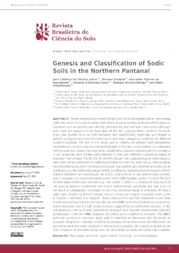Genesis and Classification of Sodic Soils in the Northern Pantanal.
Genesis and Classification of Sodic Soils in the Northern Pantanal.
Author(s): OLIVEIRA JUNIOR, J. C. de; CHIAPINI, M.; NASCIMENTO, A. F. do; COUTO, E. G.; BEIRIGO, R. M.; VIDAL-TORRADO, P.
Summary: The simultaneous occurrence of high levels of exchangeable sodium percentage (ESP) and alkalinity in soils imposes restrictions on plant development and affects physical properties such as porosity, bulk density, permeability, and hydraulic conductivity. Although sodic soils are frequent in the flood plain of the São Lourenço River, northern Pantanal, Brazil, few studies focus on their formation and classification, especially with regard to specific processes and detailed classification into lower categorical levels by the different systems available. The aim of this study was to identify the predominant pedogenetic processes occurring in sodic soils of the flood plain of the São Lourenço River to understand their genesis and assess how taxonomic classification systems contemplate the variations in soil properties. Five profiles were selected in sites with different progressive stages of dissection from erosion (P1, P2, P3, P4, and P5). At each site, a pit was dug for morphological description of the profiles and for collecting samples for chemical, particle size, mineralogical, micromorphological, and chronological analyses. Each profile was classified according to the Soil Taxonomy, World Reference Base (WRB), and Brazilian Soil Classification System (SiBCS/ Sistema Brasileiro de Classificação de Solos). Argilluviation is the predominant process, with a localized and intense ferrolysis action in the E/Bt transition zones in profile P5. Soils showed signs of lithologic discontinuity. This makes it difficult to distinguish how much of the textural gradient is inherited from fluvial sedimentation processes and how much is the result of pedogenetic processes. In the most advanced stage of alteration, P5 had a paler color, thickening of the E horizon, and an abrupt and irregular transition entering the Bt horizon in the form of a ?tongue?. When passing from the most preserved to the most eroded area, ferrolysis becomes more intense in the E/Bt transition, the electrical conductivity values decrease, and the ESP values increase, suggesting the sodification process. Under Soil Taxonomy criteria, P5 was classified as Natraqualf and the other profiles were classified as Natrudalf; under the WRB, however, all profiles were classified as Solonetz. The SiBCS exhibited variation at the Order level, with P5 classified as Planossolo and the others as Luvissolo. Despite an indication of different processes at the Order level, the SiBCS does not yet contemplate the sodic character in the studied Luvissolos. We propose inclusion of the sodic character at the Great Group level, as has already occurred with other SiBCS classes.
Publication year: 2017
Types of publication: Journal article
Keywords: Argilluviation, Ferrolysis, Luvissolo, Planossolo
Observation
Some of Embrapa's publications are published as ePub files. To read them, use or download one of the following free software options to your computer or mobile device. Android: Google Play Books; IOS: iBooks; Windows and Linux: Calibre.
Access other publications
Access the Agricultural Research Database (BDPA) to consult Embrapa's full library collection and records.
Visit Embrapa Bookstore to purchase books and other publications sold by Embrapa.

